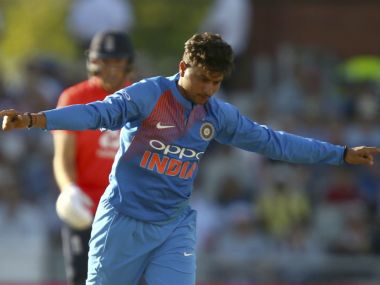Cardiff: After a resounding defeat in the first T20I at Manchester, there were still noises of celebration emanating from the England dressing room late on Tuesday evening. No, they weren’t happy with the loss for they discussed it at length, before watching the English football team progress to the quarter-finals of the 2018 World Cup. Yes, England had won on penalties that day, and little else mattered. In a way, cricket is almost an after-thought at present. Even Old Trafford was packed with Indian supporters, and much the same is expected at Cardiff. Even while the second T20I is being played here on Friday, manager Gareth Southgate will be hosting his pre-quarters presser in Russia. All attention will be away from cricket, again. Because, well, “It’s coming home!” [caption id=“attachment_4679501” align=“alignleft” width=“380”] India’s Kuldeep Yadav tormented England in the 1st T20I. AP[/caption] That chant is everywhere. On social media, on air whether television or radio, even at press conferences, as Chris Jordan tried to talk about the impending match. With Germany, Argentina, Spain and Portugal going home early, the general consensus — and not only in drunken pubs — is that England will be able to deal with Sweden on Saturday, and the winner of Croatia-Russia on Wednesday, and then, the stars will also align for them to beat whoever among Uruguay, France, Belgium and Brazil qualify for the final next Sunday. In this melee, a simple question has been almost sidelined. Can another England deal with Kuldeep Yadav? A lot is at stake when it comes to that particular question. Turn back time to February, when India were in South Africa, playing the limited-overs leg of that tour. The schedule was hectic, with matches played almost every second or third day, and an entire month passed almost in the blink of an eye. In that interim, the Proteas decided to learn how to play wrist spin. So much so, early in that six-match series, they invited seven wrist spinners to their net session in Cape Town. Of course, it didn’t help much. You cannot replicate the quality of Kuldeep and Yuzvendra Chahal in nets, and India duly won 5-1 in ODIs and 2-1 in the T20Is. What have England done to replicate wrist spin? The answer is in the name Merlyn, a spin-bowling machine that can replicate any delivery. Its name is derived from Merlin, who was a wizard in the ancient British legend of King Arthur. In that way, it sounds pretty apt for a bowling machine that can replicate any spin bowler. “Playing against Merlyn is ‘over-training’ actually, because it obviously does spin and bounce a lot more. But if you come out of a Merlyn session you’re in pretty good order,” said all-rounder Chris Jordan ahead of the game. Imagine a leg-break delivery that spins and bounces a lot more than the actual deliveries Yadav or Chahal can bowl. If you ready to deal with that exaggerated movement, then you are at least mentally prepared to play whatever is bowled at you. The differentiation though is in the human factor. For example, Chahal bowls two different types of googlies — one that slides on, and the other that comes with the arm. The trick is to identify which one Chahal is bowling by his delivery stride, because his head is more side-on in one of them. Can a machine replicate this? No. Further, there is the adaptation bit. Yadav was able to calculate that a lack of pace and more loop on the ball would stretch out English batsmen, and make them work harder to hit the big shots. He was correct in his assessment, of course. A bowling machine can only be programmed to throw down what you want it to, and unpredictability comes in only to a certain degree. There is mechanism to make the batsman think on his feet, at least not until artificial intelligence creeps into cricket practice. Whether Merlyn has an impact on England’s fortunes or not is mere conjecture at the moment. Practicality dictates that the hosts change their batting line-up a bit, with Joe Root or Jonny Bairstow coming in at number three and four respectively, while Alex Hales and Eoin Morgan need to drop down. It allows Root and Bairstow to face more balls and get going, which will be easier if they have another good start against pace. The number of deliveries they face before Yadav hurls his googly at them is going to be a crucial factor in this game. Meanwhile, India will be going in with the same playing eleven as in the first game. There is seldom need to change a winning combination, and even less when it is such a comprehensive win. There is a school of thought that says Virat Kohli could promote himself to number three, if India bat first, just to get a taste of rotation going in this batting line-up. After all, with an early 1-0 lead and a series’ win in sight, now is the time to mix things up a bit. Teams: India: Virat Kohli (c), Shikhar Dhawan, Rohit Sharma, KL Rahul, Suresh Raina, Manish Pandey, MS Dhoni (wk), Dinesh Karthik, Yuzvendra Chahal, Kuldeep Yadav, Krunal Pandya, Bhuvneshwar Kumar, Deepak Chahar, Hardik Pandya, Siddarth Kaul, Umesh Yadav. England: Eoin Morgan (c), Moeen Ali, Jonny Bairstow, Jake Ball, Jos Buttler (wk), Sam Curran, Alex Hales, Chris Jordan, Liam Plunkett, Adil Rashid, Joe Root, Jason Roy, David Willey, Dawid Malan.
Can England deal with Kuldeep Yadav? A lot is at stake when it comes to that particular question.
Advertisement
End of Article


)

)
)
)
)
)
)
)
)



